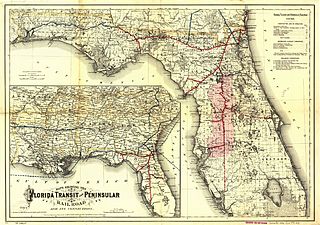
Swainsboro is a city in Emanuel County, Georgia, United States. As of the 2020 census, the city had a population of 7,425. The city is the county seat of Emanuel County.

The city of Ocilla is the county seat of Irwin County, Georgia, United States. Its population was 3,498 at the 2020 census. Ocilla is part of the Fitzgerald micropolitan statistical area.

The Florida Times-Union is a daily newspaper in Jacksonville, Florida, United States. Widely known as the oldest newspaper in the state, it began publication as the Florida Union in 1864. Its current incarnation started in 1883, when the Florida Union merged with another Jacksonville paper, the Florida Daily Times.

The Seaboard Air Line Railroad, which styled itself as "The Route of Courteous Service", was an American railroad that existed from April 14, 1900, until July 1, 1967, when it merged with the Atlantic Coast Line Railroad, its longtime rival, to form the Seaboard Coast Line Railroad. Predecessor railroads dated from the 1830s and reorganized extensively to rebuild after the American Civil War. The company was headquartered in Norfolk, Virginia, until 1958, when its main offices were relocated to Richmond, Virginia. The Seaboard Air Line Railway Building in Norfolk's historic Freemason District still stands and has been converted into apartments.

The Florida Central and Peninsular Railroad was the final name of a system of railroads throughout Florida, becoming part of the Seaboard Air Line Railway in 1900. The system, including some of the first railroads in Florida, stretched from Jacksonville west through Tallahassee and south to Tampa. Much of the FC&P network is still in service under the ownership of CSX Transportation.

The Plant System, named after its owner, Henry B. Plant, was a system of railroads and steamboats in the U.S. South, taken over by the Atlantic Coast Line Railroad in 1902. The original line of the system was the Savannah, Florida and Western Railway, running across southern Georgia. The Plant Investment Company was formed in 1882 to lease and buy other railroads and expand the system. Other major lines incorporated into the system include the Savannah and Charleston Railroad and the Brunswick and Western Railroad.
The Kansas, Oklahoma and Gulf Railway (“KO&G”) had at its height 310.5 miles of track from Denison, Texas through Oklahoma to Baxter Springs, Kansas. Its various predecessor companies built the line between 1904 and 1913. The railroad was consolidated into a Missouri Pacific Railroad subsidiary—the Texas and Pacific Railway—in 1963.
The Atlantic Short Line Railway was chartered on May 24, 1890, and formed on December 9, 1892, from the failed Macon and Atlantic Railway. Leadership consisted of John R. Young, president, W.C. Hartridge, secretary and treasurer, and J.T. Millen, general superintendent. It managed to build a 29-mile (47 km) stretch of railroad east out of Brewton, Georgia, before going bankrupt. Allegations arose that the railway's directors sought to defraud investors by enabling a monopoly of rail transportation in Georgia led by Southern Railway. It was sold to the Central of Georgia Railway in 1896 and reorganized as the Bruton and Pineora Railway in 1897.
The Augusta and Florida Railway (A&F) was incorporated in 1904 and operated a line between Keysville and Midville, Georgia, USA. The railway company was chartered on November 16, 1904, with an initial capital stock of $1 million to build about 60 miles (97 km) of line from Augusta to Midville. Construction began soon after incorporation with 16 miles (26 km) of track completed by December 1904. The A&F was sold in pieces to the Georgia and Florida Railway in 1907 and 1910. Several lines in and around Augusta made connections to the line in 1907 in association with the Georgia & Florida purchase.
Stevens Crossing, Georgia, is a small rural community in northeastern Emanuel County, approximately 2 miles north of Summertown, Georgia, and 3 miles south of the Ogeechee River at Midville, Georgia, along Georgia Highway 56. The community of Stevens Crossing was named after the junction of the Midland Railway (Georgia) with the Georgia and Florida Railroad (1926–63) mainline that was constructed on the land of Ben B. Stevens in the early 1900s. A United States Post Office at Stevens Crossing, and a Georgia & Florida depot at Stevens Crossing began operations in 1914, as did the Sutton and Stevens saw mill. The post office ceased operations in March 1939; the Stevens Crossing to Statesboro line was abandoned in 1950, and the depot and the old Midland Railway tracks removed several years later. In 2004, the Heart of Georgia Railroad subleased the portion of the old Georgia & Florida mainline that ran from Midville, Georgia to Vidalia, Georgia . Today, several descendants of the Stevens and Coleman families live in the community, and the community is also home to the Stevens Crossing Dove Club, owned and operated by a grandson of Ben B. Stevens. The Stevens Family Cemetery is located about one half mile west of the actual old crossing on Stevens Cemetery Road.
The Douglas, Augusta & Gulf Railway was created as a subsidiary of the Georgia & Florida Railway (G&F) to consolidate lines of several smaller railroads.

The Heart of Georgia Railroad is a shortline railroad created in 1999 to lease and operate 177 miles (285 km) of track owned by the Georgia Department of Transportation between Mahrt, Alabama and Vidalia, Georgia, in the United States. The railroad has since expanded to include more than 233 miles (375 km) of track, reaching as far as Midville, Georgia. Initially only the portion from Rochelle to Preston, Georgia was utilized, with the Preston-Mahrt and Rochelle-Vidalia lines out of service. The Heart of Georgia also hosts the SAM passenger excursion train and is owned by parent company Atlantic Western Transportation Company.
Seals is an unincorporated location in Camden County in the state of Georgia, United States. Its position is at 30°52′22″N81°42′15″W at an elevation of 21 feet.

U.S. Highway 1 (US 1) in the U.S. state of Georgia, which is concurrent for almost its entire length with State Route 4 (SR 4), is a highway traversing south–north through portions of Charlton, Ware, Bacon, Appling, Toombs, Emanuel, Jefferson, and Richmond counties in the southeastern and east-central parts of the state. In Georgia, the highway originates at US 1/US 23/US 301/State Road 15 (SR 15) at the St. Marys River and the Florida state line, where SR 4 reach their southern terminus. It travels to the Savannah River at the South Carolina state line in Augusta where the route continues to North Augusta, South Carolina. Here, SR 10 reaches its eastern terminus.

State Route 4 (SR 4) is a state highway in the eastern part of the U.S. state of Georgia. Except for its northernmost portion, it is completely concurrent for its entire length with U.S. Route 1 (US 1). It traverses south-to-north through portions of Charlton, Ware, Bacon, Appling, Toombs, Emanuel, Jefferson, and Richmond counties in the southeastern and east-central parts of the state. The highway begins at the Florida state line, on US 1/US 23/US 301/SR 15 at the St. Marys River. It travels to its northern terminus at the South Carolina state line, on the Augusta–North Augusta, South Carolina city line, on US 25 Business at the Savannah River.

U.S. Route 221 (US 221) in the U.S. state of Georgia is a south–north U.S. Highway. It travels from the Florida border near the Quitman area to the South Carolina state line, north of Pollards Corner. The highway connects North Central Florida with Upstate South Carolina.
The Florida Central and Western Railroad was a rail line built in the late 1800s that ran from Jacksonville west across North Central Florida and the part Florida Panhandle through Lake City and Tallahassee before coming to an end at Chattahoochee. The line was later part of the Seaboard Air Line Railroad network from 1903 to 1967, and was primarily their Tallahassee Subdivision. The full line is still in service today and is now part of the Florida Gulf and Atlantic Railroad.
The Florida Gulf and Atlantic Railroad is a shortline railroad owned and operated by RailUSA in the Florida Panhandle. The line consists of 430 miles of track: a main line from Baldwin, Florida, through Tallahassee to Pensacola, as well as a branch from Tallahassee north to Attapulgus, Georgia.
The Live Oak, Tampa and Charlotte Harbor Railroad was a historic railroad in Florida chartered by railroad tycoon Henry B. Plant. It was built as an extension of Plant's Live Oak and Rowlands Bluff Railroad. Together, the two lines ran from Live Oak, Florida to Gainesville via High Springs. The lines were completed in 1884.









